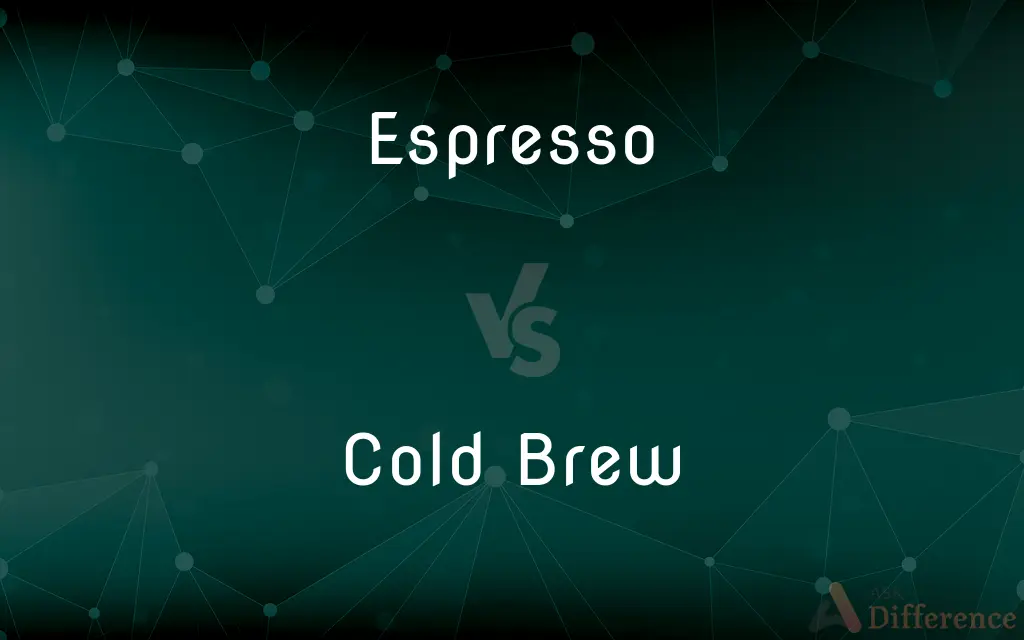Espresso vs. Cold Brew — What's the Difference?
By Fiza Rafique & Maham Liaqat — Published on July 17, 2024
Espresso is a concentrated coffee brewed by forcing hot water through finely-ground coffee beans, known for its strong flavor and creamy layer. Cold brew is made by steeping coarsely ground coffee in cold water, resulting in a smooth, mild flavor.

Difference Between Espresso and Cold Brew
Table of Contents
ADVERTISEMENT
Key Differences
Espresso and cold brew represent two distinct methods of coffee preparation, each with unique characteristics and flavor profiles. Espresso, often associated with Italian coffee culture, is made using a high-pressure brewing process that extracts the coffee's rich flavors and aromatic oils quickly, typically in under 30 seconds. This method produces a small, concentrated shot of coffee with a notable intensity and a layer of crema on top, a hallmark of a well-made espresso.
Cold brew, on the other hand, takes a much longer approach, requiring coarse coffee grounds to be soaked in cold water for 12 to 24 hours. This slow extraction process doesn't involve heat, which significantly reduces the acidity and bitterness found in traditional coffee brewing methods. The result is a smooth, mild coffee concentrate that can be diluted with water or milk and served cold, offering a refreshing alternative to hot coffee.
The caffeine content in espresso is higher per ounce than in cold brew, but because cold brew is typically consumed in larger quantities, the total caffeine intake can be similar or even higher in a serving of cold brew compared to a single shot of espresso.
Flavor-wise, espresso is characterized by its bold, robust flavor, with potential notes of chocolate, fruit, and spices, depending on the coffee blend. Cold brew offers a smoother, sweeter taste experience, often with subtle chocolate and nutty undertones, making it appealing to those who prefer a less acidic coffee.
The choice between espresso and cold brew often comes down to personal preference regarding taste, temperature, and caffeine content. Espresso serves as a quick, intense coffee experience, often enjoyed in smaller quantities, while cold brew provides a gentler, more refreshing option that can be sipped over a longer period.
ADVERTISEMENT
Comparison Chart
Brewing Time
Under 30 seconds
12 to 24 hours
Temperature
Hot
Cold
Flavor Profile
Strong, bold, with potential crema
Smooth, mild, less acidic
Caffeine Content
High per ounce
Lower per ounce but higher per serving
Acidity
Higher
Lower
Serving Size
Small (1-2 ounces)
Larger, diluted to taste
Compare with Definitions
Espresso
A concentrated coffee with a creamy layer on top.
He ordered a double espresso to kick-start his morning.
Cold Brew
Characterized by its smooth, mild flavor.
The cold brew was so smooth, it didn't need any sugar.
Espresso
Known for its strong flavor.
The espresso's bold taste was the perfect pick-me-up.
Cold Brew
Coffee steeped in cold water for an extended period.
He prepared his cold brew concentrate for tomorrow's breakfast.
Espresso
Brewed quickly under high pressure.
The espresso machine hissed as it extracted the rich, dark coffee.
Cold Brew
Less acidic than traditional coffee.
She preferred cold brew for its gentle effect on her stomach.
Espresso
Served in small amounts.
She savored her tiny cup of potent espresso after dinner.
Cold Brew
Served cold, often over ice.
On hot days, a glass of cold brew over ice was her go-to refreshment.
Espresso
Can be the base for other drinks.
A shot of espresso forms the foundation of her favorite latte.
Cold Brew
Can be diluted with water or milk.
She mixed her cold brew concentrate with almond milk for a creamy drink.
Espresso
A strong coffee brewed by forcing hot water under pressure through darkly roasted, finely ground coffee beans.
Espresso
A serving of this beverage
Ordered an espresso with dessert.
Espresso
A concentrated coffee beverage brewed by forcing hot water under high pressure through finely ground coffee.
Espresso
A drink that includes espresso as an ingredient.
Espresso
Strong black coffee brewed by forcing hot water under pressure through finely ground coffee beans
Common Curiosities
Why does espresso have crema?
Crema forms from the emulsion of coffee oils and brewing water under high pressure, characteristic of a quality espresso.
Can I make cold brew at home easily?
Yes, cold brew can be easily made at home by steeping coarse coffee grounds in cold water for 12 to 24 hours and then straining.
Is cold brew less acidic than hot coffee?
Yes, the cold brewing process extracts less acid from coffee, making cold brew smoother and less acidic.
Which has more caffeine, espresso or cold brew?
Espresso has more caffeine per ounce, but cold brew servings typically contain more total caffeine due to their larger size.
Is cold brew stronger than espresso?
Espresso is stronger in flavor and concentration, but cold brew can have a similar or higher caffeine content when served in larger volumes.
What's the best way to enjoy cold brew?
Cold brew is versatile; it can be enjoyed over ice, diluted with water or milk, and sweetened to taste.
How should I serve espresso?
Espresso is traditionally served in small cups, either alone or with a small amount of sugar, if desired.
Do I need special equipment to make espresso at home?
Yes, making traditional espresso requires an espresso machine that can generate enough pressure to extract the coffee.
Can I heat up cold brew to make it hot?
Yes, cold brew coffee can be heated for a smooth, less acidic hot coffee option.
Why is cold brew more expensive at coffee shops?
The extended brewing time and the amount of coffee used to make cold brew concentrate contribute to its higher price point.
Share Your Discovery

Previous Comparison
Sculpture vs. Ceramics
Next Comparison
Accounting vs. Financial AccountingAuthor Spotlight
Written by
Fiza RafiqueFiza Rafique is a skilled content writer at AskDifference.com, where she meticulously refines and enhances written pieces. Drawing from her vast editorial expertise, Fiza ensures clarity, accuracy, and precision in every article. Passionate about language, she continually seeks to elevate the quality of content for readers worldwide.
Co-written by
Maham Liaqat












































